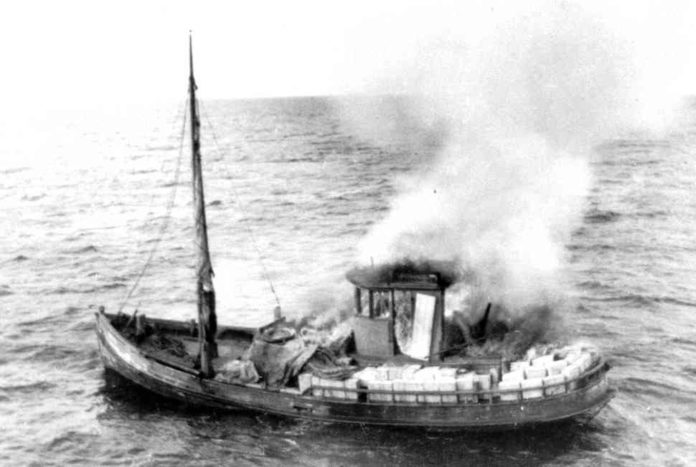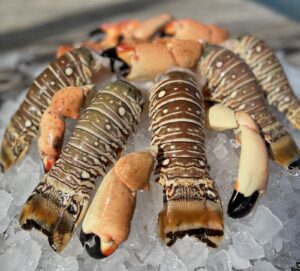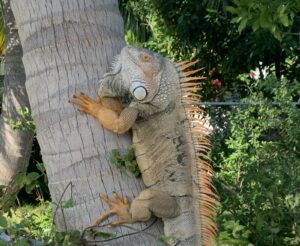By every account, Marie was quite a woman. Born in 1903 to a Swedish father and Mexican mother, she grew up to be 6 feet tall with olive skin, blue eyes, and long, flowing black hair.
If the stories are to be believed, and there are heaps and gobs of them told about her, she was equal parts charisma and cunning.
As a young girl, she met a man of infamy named Charlie Waite; his family had ties to Key West. Charlie spent time in Havana, which is likely where he met Marie when she was still a young girl. The two married, moved to Miami and bought a boat in 1924. There, Charlie and Marie Waite opened the Miami Academy of Dance. It was Prohibition, and the studio was a front for the family business: rum-running. Charlie Waite was known as the king of the rum runners who brought liquor from the Bahamas and Cuba to a thirsty Florida.
Charlie Waite had the reputation as the kind of smuggler who would not give up his booze without a fight. When the Coast Guard caught up with Waite and his small crew was apprehended in 1927, a failed escape attempt ensued. Two of the three captives were shot and killed, including Charlie, who fell overboard and into Biscayne Bay when a bullet struck his head. His body was never recovered.
The bereaved wife, Marie, stepped in and took over the family business. It was not long before Marie Waite was recognized as the infamous Spanish Marie. It did not take long for Spanish Marie to rise to the top of the rum-running realm operating in the Straits of Florida. At the height of her rum-running career, which was not a lengthy one, she oversaw 15 boats.
Like her husband, Spanish Marie ran her contraband from the Bahamas and Cuba and delivered it to Key West and South Florida. At first, her smugglers made the run across the Straits of Florida in groups of four. Three boats would be stockpiled with cases of liquor, while the fourth was armed with men ready to fight. Should the Coast Guard arrive and attempt to apprehend the rum runners, the armed boat would engage the government while the other three ships escaped to offload their contraband to speed boats waiting to run the booze to Miami or Key West.
The operation was tried and true with a proven record of success. When the Coast Guard invested in faster ships capable of outrunning the rum runners, Spanish Marie devised a new plan and equipped all of the boats in her crew with radios. She also installed a pirate radio transmitter in Key West so that the Coast Guard could hear what she was broadcasting through the airwaves. Knowing people were listening, she provided false information to confuse and misguide the government ships working to intercept her rum runners. She also created a secret set of codes spoken in simple Spanish terms that told her people where to go and whom to meet.
By the late months of 1927, she was at the height of her legendary career. But the government was starting to crack her Spanish code, and, on March 12, 1928, her luck came to an end. A load was arriving from Bimini, and, in the middle of the night, Marie received a phone call saying that the booze had safely arrived. Thinking it would be a quick job of unloading the crates, Marie left her Miami home and two small children and drove to Coconut Grove to meet her contact and complete the job.
Spanish Marie was apprehended by the Coast Guard on a Coconut Grove beach offloading contraband from her boat Kid Boots. While in custody, she pleaded to be let go to tend to her poor children. The government was sympathetic, and Marie was released on $500 bail so that she could go home and take care of her family. The agreement was that she would appear in court to face the judge the following day. Mrs. Waite’s attorney showed up, but she never did. Her lawyer claimed Marie was suffering undue mental trauma. Her bond was increased to $3,000, and the date of arraignment extended. None of it mattered; she had never planned to appear in court. Spanish Marie and her boats disappeared, along with what was alleged to be $1 million
This, however, was not the end of Spanish Marie’s story. Marie remarried and became Mrs. Marie Fritz. Her act did not change much, and she would be arrested from time to time over the next few years. According to the Dec. 2, 1938 edition of the Miami Herald, Mrs. Marie Fritz, formerly Spanish Marie, had again been arrested on a liquor charge. Prohibition was over but driving a car under the influence was still illegal, and she was found guilty of drunk driving.
While Mrs. Marie Fritz died decades ago, Spanish Marie lives on in Key West – at least in spirit or spirits. Paul Menta, owner and operator of Key West First Legal Rum Distillery, created Bad Bitch Rum – Spanish Marie in her honor. The rum is aged in French oak barrels with a hint of red wine because legend says that the beautifully notorious rum runner used to cut her rum with a little red wine.
























